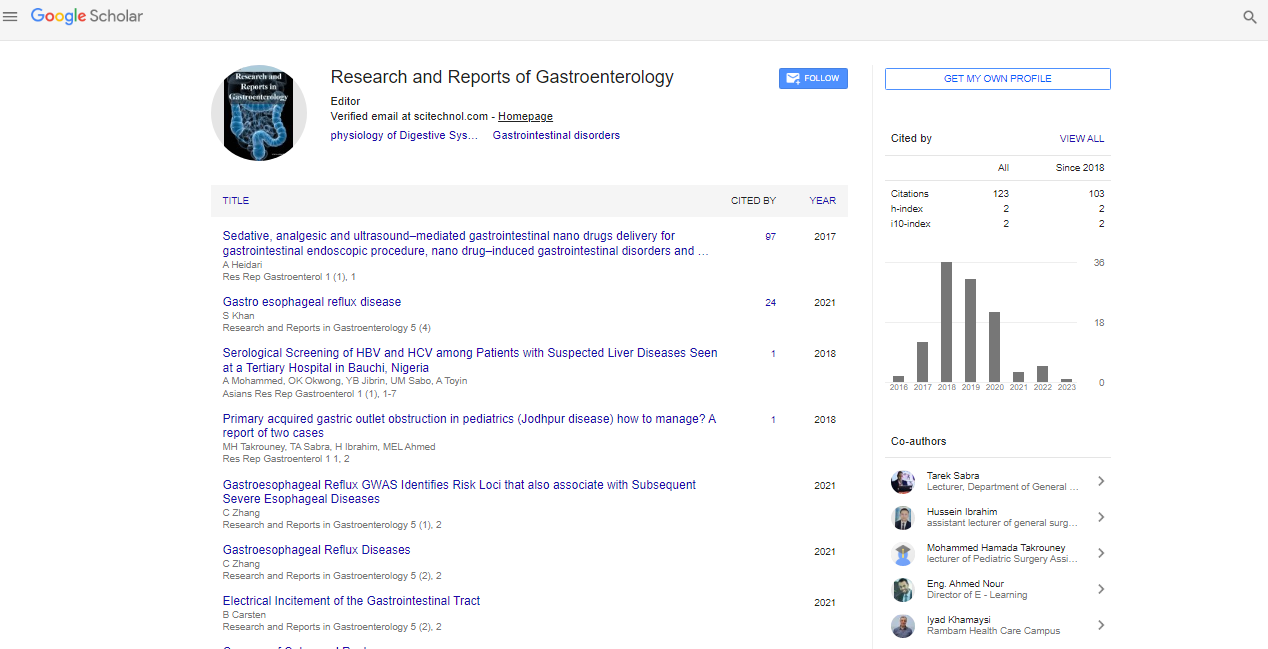Opinion Article, Res Rep Gastroenterol Vol: 7 Issue: 4
Exploring Gut-Associated Lymphoid Tissue and its Crucial Role
Alexander Matsukuma*
1Department of Pathology and Laboratory Medicine, UC Davis Medical Center, Sacramento, USA
*Corresponding Author: Alexander Matsukuma,
Department of Pathology and
Laboratory Medicine, UC Davis Medical Center, Sacramento, USA
E-mail: matsukumaalexander@gmail.com
Received date: 20 November, 2023 Manuscript No. RRG-24-124060;
Editor assigned date: 22 November, 2023, PreQC No. RRG-24-124060 (PQ);
Reviewed date: 06 December, 2023, QC No. RRG-24-124060;
Revised date: 13 December, 2023, Manuscript No. RRG-24-124060 (R);
Published date: 20 December, 2023, DOI: 10.4172/Rrg.1000158
Citation: Matsukuma A (2023) Exploring Gut-Associated Lymphoid Tissue and its Crucial Role. Res Rep Gastroenterol 7:4.
Description
The human Gastrointestinal (GI) tract is a complex ecosystem where digestion, nutrient absorption, and immune defense collaborate in intricate harmony. At the heart of this defense mechanism lies the Gut-Associated Lymphoid Tissue (GALT), a crucial component of the immune system dedicated to safeguarding the intestinal environment. In this article, we explore the fascinating world of GALT, its structure, functions, and its pivotal role in maintaining the delicate balance between protection and tolerance within the gut.
Structure of gut-associated lymphoid tissue
GALT is an extensive network of immune cells strategically distributed throughout the mucosal lining of the GI tract. Comprising various specialized structures, GALT includes Peyer's patches, isolated lymphoid follicles, and mesenteric lymph nodes. Peyer's patches are prominent lymphoid nodules found in the small intestine, while isolated lymphoid follicles are scattered throughout the mucosa, and mesenteric lymph nodes are situated in the mesentery the tissue that connects the intestines to the abdominal wall.
GALT acts as a vigilant sentinel, continuously monitoring the gut for potential threats such as pathogens, toxins, or harmful substances. Specialized immune cells, including T cells, B cells, and antigenpresenting cells, collaborate to detect and respond to foreign invaders.
The mucosal surfaces of the GI tract are exposed to an array of antigens from ingested food, commensal bacteria, and potential pathogens. GALT plays a crucial role in sampling these antigens and presenting them to immune cells, facilitating the initiation of an immune response when necessary.
GALT is a key site for the production of immunoglobulins, particularly IgA. Immunoglobulin A is essential for mucosal immunity, providing a first line of defense against pathogens by neutralizing and preventing their attachment to the mucosal lining.
Maintaining tolerance to harmless antigens, such as food particles and commensal bacteria, is equally crucial for the proper functioning of the GI tract. GALT contributes to the induction of immune tolerance, preventing unnecessary immune responses against beneficial components of the gut microbiota and dietary substances.
Interplay with gut microbiota
The gut microbiota, a diverse community of microorganisms residing in the GI tract, plays a pivotal role in the development and function of GALT. The dynamic interaction between GALT and the microbiota is essential for maintaining a harmonious balance between protective immunity and tolerance. Commensal bacteria contribute to the education and maturation of immune cells within GALT, influencing their responses to antigens and promoting the development of a well-regulated immune system.
Disruptions in the delicate balance of GALT function can contribute to various gastrointestinal and systemic diseases. Inflammatory Bowel Diseases (IBD), such as Crohn's disease and ulcerative colitis, are characterized by chronic inflammation of the GI tract, often involving an abnormal immune response within GALT. Autoimmune disorders and allergic reactions may also be linked to dysregulation in the immune processes coordinated by GALT.
Understanding the intricate relationship between GALT and gut health has significant therapeutic implications. Strategies aimed at modulating GALT function are being explored for the treatment of various GI disorders. Probiotics, which are beneficial bacteria, have shown promise in promoting a balanced immune response within GALT and supporting gut health. Additionally, research into the development of vaccines that target GALT for the prevention of infectious diseases is ongoing, highlighting the potential of harnessing the immune capabilities of GALT for preventive medicine.
Gut-associated lymphoid tissue serves as a dynamic and integral component of the immune system, orchestrating immune responses, maintaining tolerance, and safeguarding the delicate balance within the gastrointestinal tract. Its complex interplay with the gut microbiota and its role in shaping immune responses make GALT a fascinating area of research with far-reaching implications for our understanding of gut health and the development of innovative therapeutic approaches. As scientific exploration continues, the potential for leveraging the protective power of GALT opens new avenues for enhancing overall health and well-being through a deeper understanding of the immune system within the gut.
 Spanish
Spanish  Chinese
Chinese  Russian
Russian  German
German  French
French  Japanese
Japanese  Portuguese
Portuguese  Hindi
Hindi 